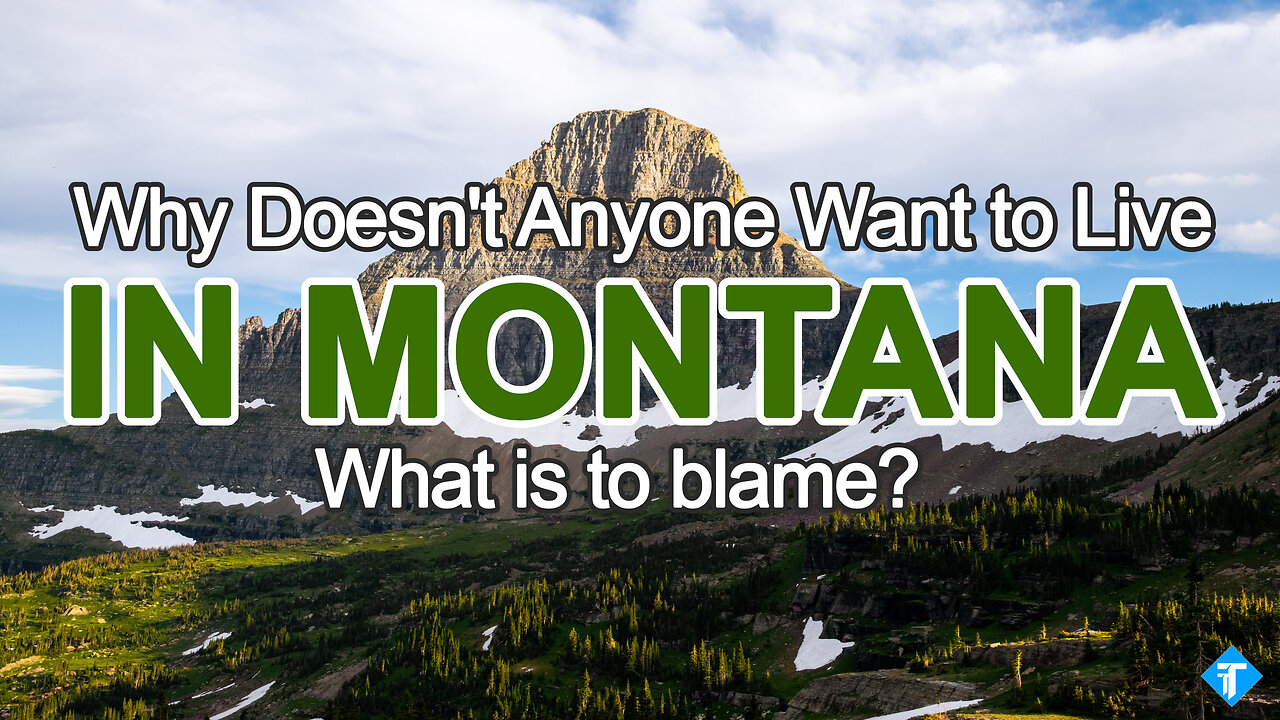Premium Only Content

Montana: Why Doesn't Anyone Want to Live There - What is to blame?
Greetings and welcome to our video which will examine the ten primary factors responsible for Montana's small population. Despite being the fourth biggest state in the United States, Montana sustains a population of slightly more than one million citizens, ranking it among the states with the smallest populations. Our video will explore the diverse elements that have led to Montana's low population.
Rugged terrain and harsh climate
Montana's rugged terrain and harsh climate present significant challenges for those seeking to settle in the state. The state's vast expanse of wilderness, including rugged mountain ranges, deep forests, and open prairies, can make it difficult to navigate and establish communities. The state's extreme weather conditions, with long, cold winters and short, intense summers, can also pose significant challenges for those unaccustomed to such conditions. The harsh winters, in particular, can make travel difficult and dangerous, with snow and ice often making roads impassable.
Moreover, Montana's remote locations and limited infrastructure can make it difficult for residents to access basic necessities and services. Many areas of the state are sparsely populated, with few stores, gas stations or medical facilities nearby. This can make it challenging for residents to obtain essential goods and services, particularly for those living in rural areas. The limited infrastructure also means that emergency services may take longer to respond to calls, which can be life-threatening in certain situations.
However, for those willing to brave the challenges, Montana's rugged terrain and harsh climate can also offer unique opportunities for adventure and exploration. The state's natural beauty, including its vast wilderness areas and scenic landscapes, is a major draw for outdoor enthusiasts. Additionally, the state's remote location and lack of development can offer a sense of peace and solitude that is hard to find in more urban areas.
Despite the challenges posed by Montana's rugged terrain and harsh climate, many residents have found ways to adapt and thrive in the state. Whether through embracing outdoor activities, building strong communities, or relying on self-sufficiency, Montana's residents have found ways to make the most of the state's unique landscape and climate.
Lack of job opportunities
The lack of job opportunities in Montana is a significant concern for the state's population. While Montana has traditionally relied on agriculture, mining, and logging industries for employment, these industries have seen a decline in recent years. The agricultural industry, in particular, has struggled to compete with larger, more industrialized farming operations in other states. Similarly, the mining industry has seen declining demand for certain minerals, leading to layoffs and closures of mines across the state.
Moreover, Montana's remote location and small population can make the state less attractive to businesses and investors, further limiting job opportunities for residents. Many businesses may be deterred by the state's lack of infrastructure and limited access to major markets, making it more difficult to establish operations in Montana.
However, Montana's unique natural resources offer opportunities for growth and development in other industries. For example, the state's abundant wind resources have led to a growing wind energy industry, providing new job opportunities for residents. The state's tourism industry, too, has seen growth in recent years, particularly with an increase in visitors seeking outdoor experiences and natural beauty.
Limited access to healthcare
Limited access to healthcare is a significant issue facing Montana's population, particularly in rural areas. The state's remote location and dispersed population make it challenging to provide healthcare services to all residents, leaving many without access to essential medical care. The problem is compounded by the fact that many healthcare providers are located in urban areas, making it even more difficult for rural residents to access medical services.
The lack of healthcare facilities in rural areas can be particularly troubling, as residents may need to travel long distances to receive medical care. This can be especially problematic for those with chronic conditions or mobility issues, who may have difficulty traveling long distances or finding transportation to medical appointments. Additionally, the long travel times can be dangerous in emergency situations, where immediate medical attention is critical.
The shortage of healthcare providers in Montana is also a concern. Many rural areas of the state have a shortage of doctors and other medical professionals, leaving residents with few options for medical care. This can be discouraging for those considering settling in Montana, particularly if they have pre-existing medical conditions or require frequent medical attention.
Despite these challenges, there are efforts underway to improve access to healthcare in Montana. Telemedicine, for example, has emerged as a promising solution for providing medical care to rural residents. This technology allows patients to access medical consultations and treatment remotely, reducing the need for travel and increasing access to medical care. Additionally, community health centers and outreach programs have been established to provide medical care to underserved populations in rural areas.
Montana's Native American history
Montana's Native American history has had a significant impact on the state's low population. Montana is home to several Native American tribes, each with their own unique history and culture. The Blackfeet, Crow, and Flathead tribes are among the most well-known, but there are many others that have called Montana home for generations.
The history of these tribes has been marked by displacement, mistreatment, and discrimination, which has contributed to a sense of mistrust and disenfranchisement among Native Americans in Montana. The forced removal of Native Americans from their ancestral lands, including the infamous Trail of Tears, had a devastating impact on these communities. The imposition of the reservation system, which confined Native Americans to designated areas of land, further limited their freedom and opportunities.
The legacy of this history is still felt today, with many Native Americans in Montana facing ongoing injustices and inequality. The lack of economic opportunities, limited access to healthcare and education, and discrimination in the justice system are just a few of the challenges faced by these communities. As a result, many Native Americans have chosen to leave Montana in search of better opportunities and more welcoming communities.
Despite the challenges faced by Native Americans in Montana, there are efforts underway to address these issues and promote greater understanding and reconciliation. Native American organizations and community leaders are working to preserve their cultures and traditions, while also advocating for greater recognition and respect. Additionally, there are ongoing efforts to improve access to education, healthcare, and economic opportunities for Native Americans in Montana.
Mining and logging industries
The boom and bust cycles of the mining and logging industries have led to a transient population in The boom and bust cycles of the mining and logging industries have had a significant impact on Montana's population. These industries have historically been major employers in the state, providing jobs and economic opportunities for residents. However, their fortunes have waxed and waned over the years, leading to a population that is less stable than in other states.
When the mining and logging industries are booming, people flood into Montana in search of work. This influx of workers can create a sense of excitement and energy in the state, as new businesses and services spring up to meet the needs of the growing population. However, when the industries decline, many of these workers are forced to leave in search of other opportunities. This can lead to a sense of instability and uncertainty in the state, as communities struggle to adapt to the changing economic landscape.
The transient nature of Montana's population has both positive and negative impacts on the state. On the positive side, it can bring new ideas and perspectives to the state, as people from different backgrounds and experiences come together. Additionally, the influx of workers during boom times can provide a much-needed economic boost to the state.
Real Estate
Montana's real estate market has experienced a surge in demand in recent years, particularly in the wake of the COVID-19 pandemic. As more people seek a quieter, more rural lifestyle, Montana's real estate market has seen an influx of buyers from other states. This has driven up prices and made it more difficult for some residents to afford homes in the state.
The COVID-19 pandemic has had a significant impact on the real estate market in Montana and across the country. As many people have shifted to remote work, they have become more interested in living in areas outside of urban centers. Montana's natural beauty and outdoor activities have made it an attractive destination for those seeking a quieter, more rural lifestyle.
This influx of buyers has contributed to a surge in demand for homes in Montana, driving up prices and making it more difficult for some residents to afford homes in the state. Additionally, the competition for homes has led to bidding wars and other challenges for buyers, particularly those with limited financial resources.
Despite the challenges facing buyers, the surge in demand has also created opportunities for sellers and real estate agents. Many homeowners in Montana have seen their property values increase significantly in recent years, providing a valuable asset for their families and communities. Additionally, the increased demand for homes has created opportunities for real estate agents and other professionals in the industry.
Overall, Montana's real estate market has experienced a surge in demand in recent years, driven by an influx of buyers seeking a quieter, more rural lifestyle. While this has created challenges for some residents, it has also created opportunities for sellers and real estate professionals.
Low population density
The low population density and limited services in Montana present several logistical challenges for residents, particularly when it comes to shopping for groceries or obtaining essential goods. Due to the lack of nearby stores or markets, many residents are forced to travel long distances, sometimes more than 20 miles, to purchase basic necessities. This can be especially problematic for those who do not have access to reliable transportation or who have mobility issues.
Additionally, the limited population in Montana means that opportunities for nightlife or dining out are scarce. With fewer people in the area, there are simply fewer options for restaurants or entertainment venues. This can make it difficult for residents to find social activities or opportunities to connect with others, particularly in rural areas. For some, this lack of social options can feel isolating and contribute to a sense of loneliness.
However, for others, the lack of nightlife and restaurants is a small price to pay for the peace and quiet of living in a sparsely populated state. Many residents of Montana appreciate the slower pace of life and the opportunity to connect with nature and the outdoors. The lack of crowds and traffic can be seen as a benefit, allowing residents to enjoy a more relaxed and laid-back lifestyle.
-
 38:05
38:05
Uncommon Sense In Current Times
14 hours agoIs Israel Being Forced Into a Bad Deal? David Rubin Exposes the Truth | Uncommon Sense
603 -

FreshandFit
9 hours agoAfter Hours w/ Girls
108K79 -
 2:33:58
2:33:58
TimcastIRL
11 hours agoDan Bongino ACCEPTS Deputy FBI Director, SECRET NSA CHATS EXPOSED w/Joey Mannarino | Timcast IRL
163K90 -
 1:09:33
1:09:33
Glenn Greenwald
16 hours agoMichael Tracey Reports from CPAC: Exclusive Interviews with Liz Truss, Steve Bannon & More | SYSTEM UPDATE #412
113K92 -
 56:02
56:02
Sarah Westall
12 hours agoBiohacking & Peptides: Weight loss, Anti-Aging & Performance – Myth vs Reality w/ Dr. Diane Kazer
66.5K30 -
 11:22
11:22
Bearing
22 hours ago"Anxious & Confused" Federal Workers FREAK OUT Over DOGE Efficiency Email 💥
93.6K77 -
 1:31:20
1:31:20
Flyover Conservatives
1 day agoUS STOCK MARKET: Sinking Ship - Dr. Kirk Elliott; How I Fought Back Against Woke Schools & Stopped Gender Bathrooms - Stacy Washington | FOC Show
78.6K4 -
 1:08:09
1:08:09
Donald Trump Jr.
17 hours agoFBI Dream Team, Plus Taking Your Questions Live! | Triggered Ep.219
227K299 -
 7:32:37
7:32:37
Akademiks
16 hours agoDrake and PartyNextDoor '$$$4U' Album Sells 250K first week. BIG AK IS BACK.
132K19 -
 3:12:08
3:12:08
MyronGainesX
15 hours ago $33.95 earnedDan Bongino Named FBI Deputy Director, Trump Meets Macron, And More!
111K33